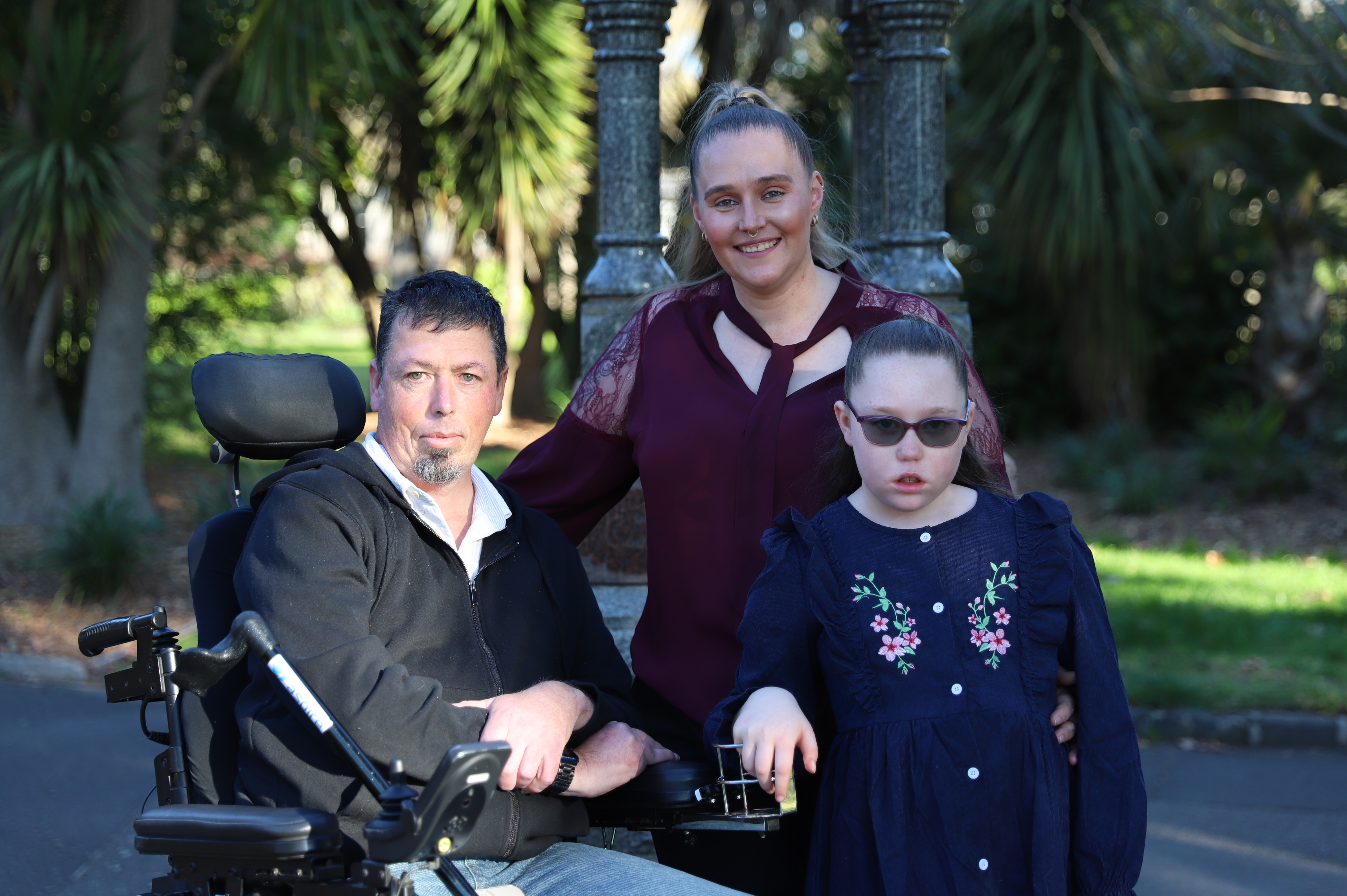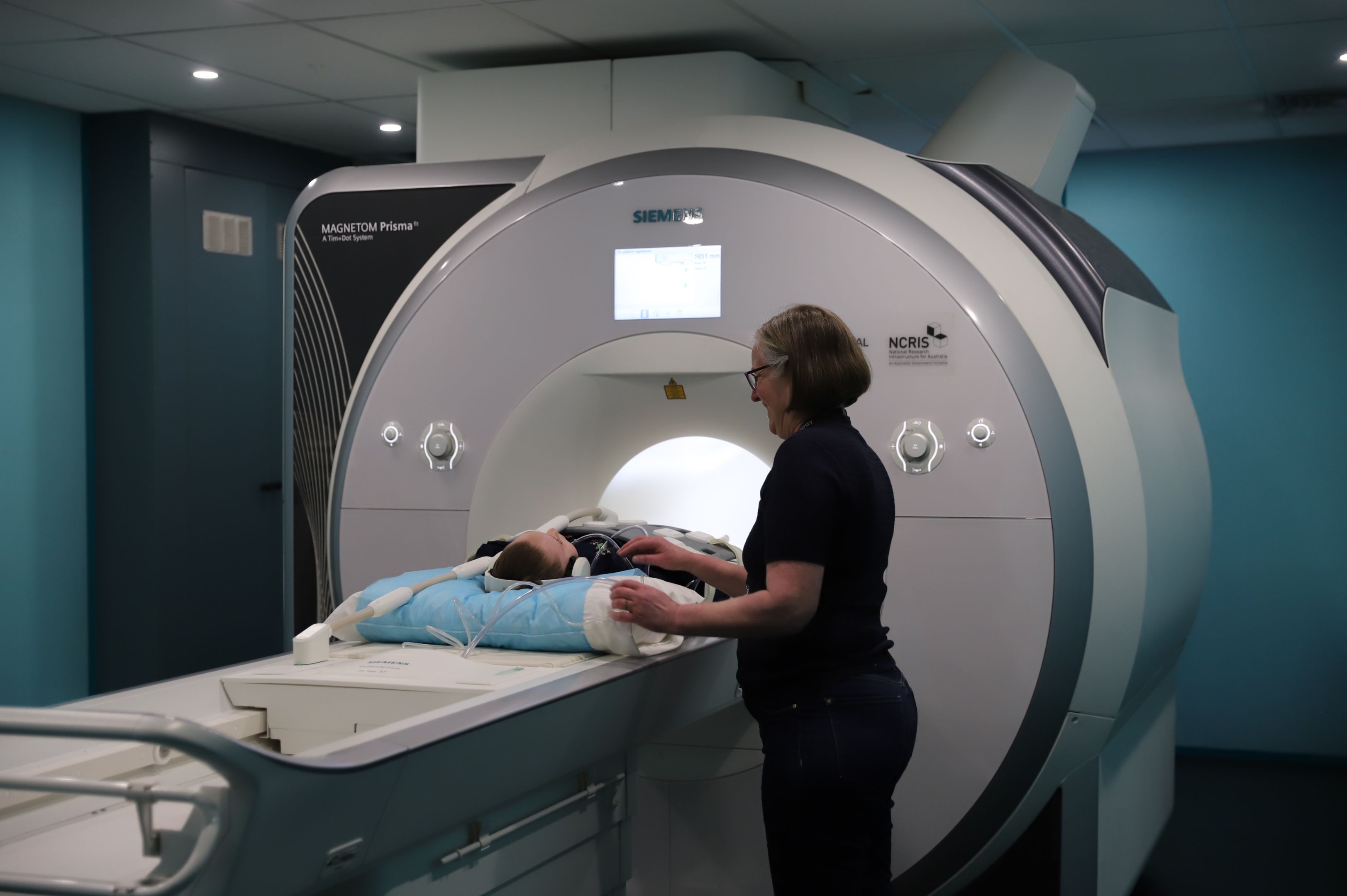World-first disease progression model offers new hope for muscular dystrophy patients

Father Mark and daughter Zaharrah Priestley live with facioscapulohumeral muscular dystrophy (FSHD).
In summary
- One in 7500 Australians have facioscapulohumeral muscular dystrophy (FSHD), a genetic disease that causes progressive weaking and loss of muscle
- Swinburne is working with the FSHD Global Research Foundation, the National Imaging Facility (NIF) and Springbok Analytics on a world-first AI disease progression model for FSHD patients
- The model shows muscle health, fat infiltration, and asymmetry in unprecedented detail, providing a pathway for precision medicine
Patients with a common type of muscular dystrophy will benefit from a world-first AI powered disease progression model with ‘life-changing’ implications, using advanced MRI imaging at Swinburne University of Technology.
Facioscapulohumeral muscular dystrophy (FSHD) is one of the more common types of muscular dystrophy affecting adults and children. It is a genetic disease that causes progressive weakening and loss of muscle, affecting people’s ability to walk, talk, smile, blink, and eat. The exact number of people affected by the disease is unknown, largely due to inadequate diagnostics and frequent misdiagnosis.
This new model relies on full-body muscle health scans collected by the FSHD Global Research Foundation, through Swinburne University of Technology and the National Imaging Facility (NIF). The project leverages Swinburne Neuroimaging's advanced MRI expertise to conduct in-depth muscle health studies, providing unprecedented detail in the analysis of living tissues.
New scans from about 50 FSHD patients were combined with international FSHD and baseline data by Springbok Analytics, who developed the disease progression model. Their technology allows patients and practitioners to compare muscle size with a similar reference population, quantify asymmetry, and identify fat infiltration.
New hope in fight against 'cruel disease'
For the Priestley family, FSHD is a daily reality. Their father, Mark, was diagnosed at the age of 18. Now 42, he requires the use of a wheelchair to travel more than a few steps at a time.
"It's life-stealing and unbelievable," he told Nine's A Current Affair.
Mark and his wife Dimity have four daughters. Nine-year-old Zaharrah was diagnosed with early-onset FSHD—a particularly aggressive form of the disease—at the age of five.
"Zari can't smile with her mouth, but she can definitely smile with her eyes," Dimity says.
Mark and Zaharrah have both had their MRI scans and received reports from Springbok. Mark says the report was critical in providing the required evidence to gain access to an electric wheelchair.
"It gives us the ability to know where we're at, and helps us sort of predict what we need next in life ... It also allows our physios to work on certain muscles, to allow us to stretch, to keep our mobility as much as possible."

Zaharrah Priestley inside the MRI machine at Swinburne Neuroimaging.
'A beacon of hope'
FSHD Global Research Foundation Managing Director, Emma Weatherley—who lives with FSHD—said the key to the new model is its predictive power.
“Patients can see their muscle health in three dimensions and track how the disease progresses over time,” she says.
“This pilot project is not just a milestone for FSHD research in Australia but a beacon of hope for everyone affected by muscle disease.”
Swinburne Neuroimaging Director, Dr David White, said it was a privilege to participate in such life-changing work.
"This project represents a significant step forward in our understanding and future treatment of FSHD,” he says.
“By harnessing cutting-edge whole-body imaging and AI technology, we are poised to make substantial advances in medical research and offer much-needed insight for patients in understanding their conditions."
Scans were collected at a range of sites across Australia, including lead site, Swinburne Neuroimaging.
The data and insights gained from this project will be instrumental in developing a standardised MRI protocol that can be implemented across the national NIF network.
NIF Chief Executive Office, Professor Wojtek Goscinski, said NIF was proud to be part of the collaboration.
“By leveraging our national network’s expertise and advanced human imaging capabilities with Swinburne’s leadership, we are positioned to drive cutting-edge impactful research that could transform the lives of those affected by this disease,” he said.
Founded in the US with offices in Australia, Springbok Analytics is a muscle health company delivering advanced musculoskeletal insights through AI-powered analysis of MRI data. Springbok’s technology provides personalized, 3D visualizations of muscle volume, composition, and symmetry, helping researchers, clinicians, and patients better understand how muscle changes over time.
Dr. Silvia Blemker, Co Founder and Chief Scientific Officer at Springbok Analytics, says: “Every person with FSHD experiences the disease differently, and that’s what makes it so difficult to track and treat. Our technology allows us to quantify individual muscles and visualize patterns that would otherwise remain hidden, making it easier to monitor progression and design more personalized interventions.
This model represents a major step forward in making muscle health data not only accessible, but actionable, for clinicians, researchers, and for the patients themselves.”

Swinburne Senior MRI Radiographer Annalaise Takla reviews scan data at the Swinburne Neuroimaging facility.
Opening pathways to precision medicine
Ms Weatherley said while the model is still in development, the scans performed at Swinburne have already delivered actionable results for patients.
“We’ve had a patient able to use this data to support their engagement with the NDIS, showing how their muscle health is affected by FSHD,” she said.
The future potential is even brighter. Ms Weatherley said the model could support both disease management and therapeutic development.
“There’s potential to develop this model into a personalised digital placebo, allowing us to track the impact of new medications against projected changes without intervention,” she said.
“Access to placebo-controlled groups can be a major barrier for research, so this could allow for faster development.”
FSHD Global Research Foundation has funded another 50 full-body scans and is fundraising to allow for scanning on an ongoing basis.
“We’re committed to expanding the use of this technology with the aim of identifying and slowing down the disease’s progression and improving muscle wellness for individuals affected by various neuromuscular disorders and the aging population,” Ms Weatherley said.
Read and watch the full story on Nine's A Current Affair.
-
Media Enquiries
Related articles
-

- Health
World-first study to develop early warning system for bipolar sufferers
A world-first Swinburne project will develop an early warning system for individuals with bipolar disorder.
Monday 08 September 2025 -

- Health
What happens if I eat too much protein?
Analysis for The Conversation by nutrition expert Dr Margaret Murray.
Tuesday 09 September 2025 -

- Health
World-first disease progression model offers new hope for muscular dystrophy patients
Patients with a common type of muscular dystrophy will benefit from a world-first AI powered disease progression model with ‘life-changing’ implications, using advanced MRI imaging at Swinburne University of Technology.
Friday 05 September 2025 -

- Health
94% of older Australians say home gardening space is extremely important, so why isn’t it part of housing crisis discussions?
94 per cent of older Australians say having gardening space where they live is extremely important, according to a new Swinburne report.
Monday 15 September 2025 -

- Technology
World first study of young adults’ brain activity shows TV and gaming boosts focus, while social media hinders it
A world-first Swinburne-led study into young adults’ brain activity has found that TV and gaming are associated with increased focus, while social media is associated with decreased focus.
Thursday 07 August 2025

